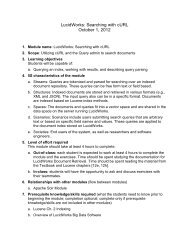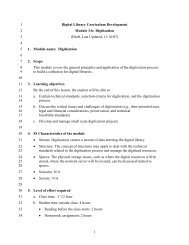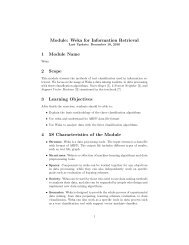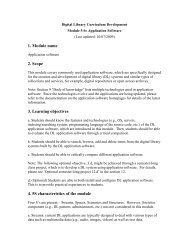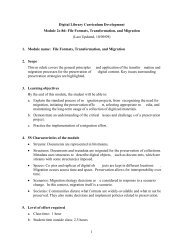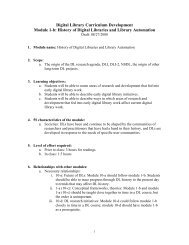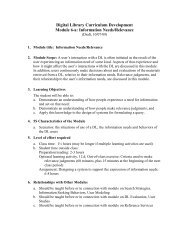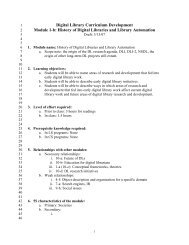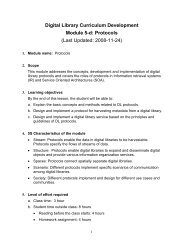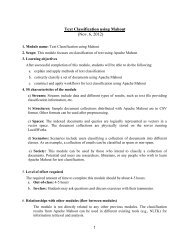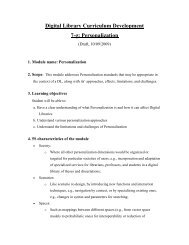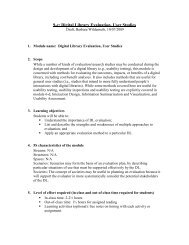1) Module: SEDNA XML DATABASE Draft: 12/09/2010 1) Module ...
1) Module: SEDNA XML DATABASE Draft: 12/09/2010 1) Module ...
1) Module: SEDNA XML DATABASE Draft: 12/09/2010 1) Module ...
Create successful ePaper yourself
Turn your PDF publications into a flip-book with our unique Google optimized e-Paper software.
1) <strong>Module</strong>: <strong>SEDNA</strong> <strong>XML</strong> <strong>DATABASE</strong><br />
<strong>Draft</strong>: <strong>12</strong>/<strong>09</strong>/<strong>2010</strong><br />
1) <strong>Module</strong> Name<br />
2) Scope<br />
<strong>SEDNA</strong> <strong>XML</strong> <strong>DATABASE</strong><br />
The module introduces the use of <strong>SEDNA</strong> xml database for xml retrieval. The primary<br />
focus of the module is to describe the architecture of <strong>SEDNA</strong> database and how standard<br />
xml queries can be used to retrieve data from it.<br />
3) Learning Objectives<br />
At the end of the module, a student will be able to<br />
i. Explain the basic concepts of xml retrieval and its relevance in IR systems.<br />
ii. Explain the architecture of <strong>SEDNA</strong>.<br />
iii. Load xml documents into the <strong>SEDNA</strong> database and perform information<br />
retrieval on the documents using xml queries.<br />
4) 5S Characteristics of the <strong>Module</strong><br />
.<br />
Ss Examples Objectives<br />
Streams <strong>XML</strong>, XQueries Describes properties of the DL<br />
content such as encoding and<br />
language for textual material<br />
or particular forms of<br />
multimedia data<br />
Structures<br />
Collection, documents,<br />
Entities, Attributes, DTD,<br />
metadata.<br />
Specifies organizational<br />
aspects of the DL content<br />
Spaces Xquery operations Defines logical and<br />
presentational views of several<br />
DL components<br />
Scenarios<br />
Searching, Querying,<br />
updating, inserting, deleting<br />
Details the behavior of DL<br />
services<br />
Societies Database administrators, Defines managers, responsible
database users, web users<br />
for running DL services;<br />
actors, that use those services;<br />
and relationships among them<br />
5) Level of Effort Required:<br />
i. Prior to Class: 2 hours of reading<br />
ii. In Class: 3 hours<br />
a. 2 hours for learning the basics of xml and implementation of xml retrieval<br />
in <strong>SEDNA</strong><br />
b. 1 hour for class discussions, exercises, and activities<br />
6) Relationship with other modules:<br />
Close connections with:<br />
a) WEKA: <strong>XML</strong> support is now available in several places in WEKA:<br />
– Command Line<br />
– Serialization of Experiments<br />
– Serialization of Classifiers<br />
– Bayesian Networks<br />
– Tools<br />
b) SOLR: SOLR package is also used to query content and retrieve information from xml<br />
documents.<br />
7) Prerequisite knowledge required:<br />
Students need to know basic concepts of UNIX commands, <strong>XML</strong>, <strong>XML</strong> database, and<br />
XQuery.<br />
8) Introductory Remedial Instruction:<br />
None<br />
9) Body of Knowledge<br />
i. What is <strong>XML</strong>?<br />
a. <strong>XML</strong> stands for extensible Markup Language.<br />
b. A markup language is used to provide information about a document.
.<br />
.<br />
.<br />
ii.<br />
iii.<br />
iv.<br />
c. Tags are added to the document to provide the extra information.<br />
d. HTML tags tell a browser how to display the document.<br />
e. <strong>XML</strong> tags give a reader some idea what some of the data means.<br />
Difference between <strong>XML</strong> and HTML<br />
a) <strong>XML</strong> is not a replacement for HTML.<br />
b) <strong>XML</strong> was designed to describe data and to focus on what data is. HTML was<br />
designed to display data and to focus on how data looks.<br />
c) HTML is about displaying information, <strong>XML</strong> is about describing information.<br />
Why Is <strong>XML</strong> Important?<br />
a) Plain Text<br />
– Easy to edit.<br />
– Useful for storing small amounts of data .<br />
– Possible to efficiently store large amounts of <strong>XML</strong> data through an <strong>XML</strong><br />
front end to a database.<br />
b) Data Identification<br />
– Tell you what kind of data you have<br />
– Can be used in different ways by different applications<br />
c) Inline Reusability<br />
– Can be composed from separate entities<br />
– Modularize your documents without resorting to links<br />
d) Hierarchical<br />
– Faster to access .<br />
– Easier to rearrange.<br />
Why <strong>XML</strong> evolved?
a) 1960-1980 Infrastructure for the Internet.<br />
b) 1986 SGML (Standard Generalized Markup Language) for defining and<br />
representing structured documents.<br />
c) 1991 WWW and HTML introduced for the Internet.<br />
d) 1991 Business adopts the WWW technology; huge expansion in the use of the<br />
Internet.<br />
e) 1995 New kinds of businesses evolve, based on the connectivity of people all<br />
over the world and connectivity of applications built by various software<br />
providers (B2C, B2B).<br />
f) Urgent need for a new, common data format for the Internet .<br />
v. <strong>XML</strong> Building blocks<br />
a) Element<br />
– Delimited by angle brackets.<br />
– Identify the nature of the content they surround.<br />
– General format: … <br />
– Empty element: <br />
b) Attribute<br />
– Name-value pairs that occur inside start-tags after element name, like:<br />
<br />
vi.<br />
Example of an <strong>XML</strong> Document<br />
<br />
<br />
John <br />
team4@vt.edu<br />
2<strong>12</strong>-346-<strong>12</strong>34<br />
1985-03-22<br />
<br />
vii.<br />
<strong>XML</strong> Trees<br />
a) An <strong>XML</strong> document has a single root node.
) The tree is a general ordered tree.<br />
a. A parent node may have any number of children.<br />
b. Child nodes are ordered, and may have siblings.<br />
c) Preorder traversals are usually used for getting information out of the tree.<br />
viii.<br />
Document Type Definitions<br />
a) A DTD describes the tree structure of a document and something about its data.<br />
b) There are two data types, PCDATA and CDATA.<br />
a. PCDATA is parsed character data.<br />
b. CDATA is character data, not usually parsed.<br />
c) A DTD determines how many times a node may appear, and how child nodes are<br />
ordered.<br />
ix.<br />
<strong>XML</strong> Database<br />
a) An <strong>XML</strong> database is a data persistence software system that allows data to be<br />
stored in <strong>XML</strong> format. This data can then be queried, exported and serialized<br />
into the desired format.<br />
b) Two major classes of <strong>XML</strong> database exist:<br />
a. <strong>XML</strong>-enabled: these map all <strong>XML</strong> to a traditional database (such as a<br />
relational database [1]), accepting <strong>XML</strong> as input and rendering <strong>XML</strong> as<br />
output. This term implies that the database does the conversion itself (as<br />
opposed to relying on middleware).<br />
b. Native <strong>XML</strong> (NXD): the internal model of such databases depends on<br />
<strong>XML</strong> and uses <strong>XML</strong> documents as the fundamental unit of storage,<br />
which is, however, not necessarily stored in the form of text files.<br />
x. What is XQuery?<br />
a) XQuery is designed to be a small, easily implemental language in which the<br />
queries are easily understood.<br />
b) It is also flexible enough to query a broad spectrum of <strong>XML</strong> information<br />
sources, including both databases and documents.<br />
c) It is human-readable query syntax and an <strong>XML</strong> based query syntax.
xi.<br />
xii.<br />
ABOUT <strong>SEDNA</strong><br />
a) Sedna is a free native <strong>XML</strong> database which provides a full range of core<br />
database services.<br />
b) It provides persistent storage, ACID transactions, security, indices, hot backup.<br />
c) Provides support for fine-grained <strong>XML</strong> triggers.<br />
d) Provides sql connection from XQuery .<br />
e) Provides XQuery external functions implemented in C.<br />
f) Provides database security (users, roles and privileges).<br />
Sedna Architecture Overview<br />
Figure 1: <strong>SEDNA</strong> Architecture Overview<br />
xiii.<br />
Sedna Architecture: Interactions between processes
Figure 2: Sedna Architecture: Interactions between processes<br />
xiv.<br />
Sedna Native <strong>XML</strong> Database Client/Server Protocol<br />
a) Sedna <strong>XML</strong> Database server uses a message-based protocol for communication<br />
with clients through the TCP/IP sockets.<br />
b) The common message structure is as follows: the first four bytes (int) is<br />
instruction, the next four bytes (int) is the length of a body in bytes; the next<br />
’length’ bytes is the body.<br />
c) To begin a session, a client creates a connection to the server and sends a startup<br />
message. The server launches a new process that is associated with the session.<br />
d) Queries are executed via different subprotocols depending on the type of the<br />
query and the query length. There are three types of queries: query, update, bulk<br />
load.
e) Termination can be initiated by the client (for example when it closed the<br />
session) or by the server (for example in case of an administrator-commanded<br />
database shutdown or some failure).<br />
xv.<br />
Sedna Query Parser & Optimizing Rewriter<br />
Figure 3: Sedna Query Parser & Optimizing Rewriter<br />
xvi.<br />
Sedna API overview<br />
a) APIs developed by our team:<br />
– C<br />
– Java<br />
– Scheme<br />
– OmniMark (Stilo’s streaming programming language used for content<br />
engineering tasks)<br />
b) APIs contributed by Sedna open source users:<br />
– Python<br />
– PHP<br />
– .Net
– <strong>XML</strong>:DB API (standard API for <strong>XML</strong> databases, supported by other<br />
products also)<br />
xvii.<br />
INSTALLING <strong>SEDNA</strong><br />
a) The installation guide can be found at<br />
http://modis.ispras.ru/sedna/install.html#bininst<br />
b) The following steps need to be followed.<br />
– Download the self extracting script from<br />
http://www.modis.ispras.ru/FTPContent/sedna/current/sedna-3.4.66-<br />
bin-linux-x86.sh .<br />
– Make the script executable by changing its permission using:<br />
chmod +x sedna-3.4.66-bin-linux-x86.sh<br />
– Execute the script by running the following command on the<br />
terminal in the directory in which the script was downloaded:<br />
./sedna-3.4.66-bin-linux-x86.sh<br />
– The operating system user that is going to run Sedna must have r-wx<br />
permissions for the following Sedna directories:<br />
$<strong>SEDNA</strong>_INSTALL/data<br />
$<strong>SEDNA</strong>_INSTALL/cfg (here $<strong>SEDNA</strong> refers to the directory in<br />
which Sedna was installed)<br />
– To grant the necessary permissions on linux execute the following<br />
command on the terminal.<br />
chown cfg data<br />
– Sedna actually needs to run 50 sessions (default maximum)<br />
simultaneously. To do this some of the kernel parameter settings<br />
have to be extended. This can be done as under.<br />
– Log on as a user with root authority<br />
– Open up /etc/sysctl.conf in a text editor and add entries:<br />
kernel.sem = "250 64000 32 256"<br />
xviii.<br />
WORKING WITH <strong>SEDNA</strong>
a) Go to INSTALL_DIR/bin ( Here INSTALL_DIR refers to the directory<br />
in which Sedna was installed)<br />
b) To start Sedna server run:<br />
./se_gov<br />
( If Sedna is started successfully it prints "GOVERNOR has been<br />
started in the background mode“)<br />
c) To shutdown Sedna server run:<br />
./ se_stop<br />
d) To create a database named testdb:<br />
./se_cdb testdb<br />
(If the database is created successfully it prints "The database<br />
'auction' has been created successfully“)<br />
e) To run the testdb database:<br />
./se_sm testdb<br />
(If the database is started successfully it prints "SM has been<br />
started in the background mode".)<br />
f) To shutdown the testdb database:<br />
./se_smsd testdb<br />
xix.<br />
WORKING WITH <strong>SEDNA</strong>(RUN QUERIES)<br />
a) The directory INSTALL_DIR/examples/commandline has an xml file<br />
named auction.xml and some sample xml queries in files named<br />
sample01.xquery to sample10.xquery.<br />
b) The directory also contains a script which uploads an xml file into the<br />
data base named load_data.xquery.<br />
c) Load the sample <strong>XML</strong> document into the auction database by typing<br />
the command in the directory:INSTALL_DIR/bin :<br />
./se_term -file INSTALL_DIR/examples/commandline<br />
load_data.xquery testdb<br />
d) Now you can execute the sample queries by typing the command:<br />
./se_term -file INSTALL_DIR/examples/commandline<br />
/.xquery testdb<br />
(where .xquery is the name of a file with the sample<br />
query).<br />
e) For instance, to execute sample01.xquery you should type:<br />
./se_term -file INSTALL_DIR/examples/commandline<br />
/sample01.xquery testdb
xx.<br />
DEMO<br />
a) Log in to the cloud instance <strong>12</strong>9.33.147.20 using the key provided and<br />
username idcuser.<br />
b) Sedna has been installed in the xml directory present in /home/idcuser.<br />
Installation<br />
folder<br />
Figure 4: <strong>SEDNA</strong> DEMO part 1
Start Sedna<br />
Create a database called auction<br />
Start data base<br />
Figure 5: <strong>SEDNA</strong> DEMO part 2<br />
Load the <strong>XML</strong><br />
document into the<br />
auction database<br />
execute the<br />
sample queries in<br />
sample02.xquery<br />
Figure 6: <strong>SEDNA</strong> DEMO part 4
xxi.<br />
DEMO:C API<br />
a) Library files are located at the <strong>SEDNA</strong>_DIR/driver/c folder, where <strong>SEDNA</strong>_DIR<br />
is the directory Sedna is installed in.<br />
b) Examples discussed in this document can be found in<br />
<strong>SEDNA</strong>_DIR/examples/api/c.<br />
c) To build examples use:<br />
gcc -I<strong>SEDNA</strong>_DIR/driver/c -osample sample.c <strong>SEDNA</strong>_DIR/driver/c/libsedna.a<br />
Figure 7: C API DEMO part 1
Figure 8: C API DEMO part 2<br />
xxi.<br />
How it Works?<br />
a) <strong>XML</strong> File<br />
<br />
<br />
<br />
<br />
……<br />
15.00<br />
<br />
<br />
<br />
….<br />
20.00<br />
<br />
<br />
<br />
<br />
…..<br />
<br />
b) Xquery<br />
(:<br />
Return the initial increases of all open auctions.<br />
:)<br />
for $b in doc("auction")/site/open_auctions/open_auction<br />
return { $b/bidder[position()=1]/increase/text() }<br />
c) Result<br />
18.00<br />
4.50<br />
3.00<br />
10.50<br />
33.00<br />
6.00<br />
10.50<br />
27.00<br />
9.00<br />
18.00<br />
33.00<br />
xxii.<br />
Wiki<strong>XML</strong>DB: Query Wikipedia with XQuery<br />
Wiki<strong>XML</strong>DB provides a way of querying Wikipedia with Xquery.<br />
a) Implementation:<br />
– Entire English Wikipedia content is parsed into <strong>XML</strong> representation (total<br />
size – about 36 GB).<br />
– Loaded into Sedna <strong>XML</strong> database.<br />
– A query interface is provided.<br />
b) Deploying Wiki<strong>XML</strong>DB<br />
– Wiki<strong>XML</strong>DB demo is deployed on Amazon EC2 and runs on the<br />
virtual computer with restricted resources.
– Can be run on local computer to achieve better performance and<br />
unlimited customization.<br />
http://wikixmldb.org/help/deployment/<br />
c) Uses of Wiki<strong>XML</strong>Db<br />
– User can dissect individual articles, rip out abstracts, sections, links,<br />
info boxes and other components of Wikipedia.<br />
– User can combine pieces of existing documents into new <strong>XML</strong><br />
documents and convert them to web pages with XSLT for example.<br />
– User can enrich his content with data from Wikipedia and unlock its<br />
power for his applications.<br />
– User can perform all these actions using W3C Xquery Language.<br />
d) Wiki<strong>XML</strong>DB Demo<br />
– <strong>XML</strong> representation of Wikipedia articles:<br />
http://wikixmldb.org/help/getting-started<br />
– Wiki<strong>XML</strong>DB Xquery interface:<br />
http://wikixmldb.org/xq/
10) Concept Map<br />
11) Exercises/Learning Activities<br />
1. Write Xqueries for the following scenarios at wiki<strong>XML</strong>DB demo page:<br />
http://wikixmldb.org/xq/<br />
a) Retrieve all titles of Wikipedia pages which contain the term “<strong>XML</strong>”<br />
b) Retrieve the categories of the Wikipedia page whose title is “Igor Kurchatov”<br />
c) Retrieve the contributors of all Wikipedia pages whose titles contain “XQuery”
2. Use the auction.xml file described in the demo. Write Xqueries for the following<br />
scenarios:<br />
a) Count the number of open auctions<br />
b) Count the number of bidders in the first open auction<br />
c) Find the date of the first bidder in the last open auction<br />
<strong>12</strong>) Evaluation of Learning Outcomes<br />
i. Are students familiar with the fundamental concepts, applications and techniques of<br />
<strong>XML</strong> retrieval?<br />
ii. Are students capable of running xqueries on the <strong>SEDNA</strong> database?<br />
This can be determined by verifying if a student can successfully load an xml document<br />
into the <strong>SEDNA</strong> database, and if he can write and execute xqueries to retrieve data from<br />
the xml document.<br />
13) Glossary<br />
i. Xml: Extensible Markup Language (<strong>XML</strong>) is a set of rules for encoding documents in<br />
machine-readable form.<br />
ii.<br />
iii.<br />
iv.<br />
Xquery: It is a query and functional programming language that is designed to query<br />
of <strong>XML</strong> data.<br />
Information Retrieval: Field of computer science which studies the retrieval<br />
of information (not data) from a collection of written documents.<br />
Database: A database consists of an organized collection of data for one or more uses,<br />
typically in digital form.<br />
v. HTML: HTML, which stands for HyperText Markup Language, is the predominant<br />
markup language for web pages.<br />
vi.<br />
vii.<br />
viii.<br />
Parser: Parser performs the process of analyzing a text, made of a sequence of tokens<br />
(for example, words), to determine its grammatical structure with respect to a given<br />
(more or less) formal grammar.<br />
API: An Application Programming Interface (API) is a particular set of rules and<br />
specifications that a software program can follow to access and make use of the<br />
services and resources provided by another particular software program that<br />
implements that API.<br />
Linux: Linux refers to the family of Unix-like computer operating systems using the<br />
Linux kernel.
14) References<br />
i. Weblinks:<br />
[1] Home Page: http://modis.ispras.ru/sedna/index.html<br />
[2] Download Page: http http://modis.ispras.ru/sedna/download.html<br />
[3] Programmers Guide: http://modis.ispras.ru/sedna/progguide/ProgGuide.html<br />
[4] XQuery Help: http://www.w3.org/<strong>XML</strong>/Query/<br />
ii.<br />
Related research publications:<br />
[5] Overview of the INitiative for the Evaluation of <strong>XML</strong> Retrieval (INEX) 2003<br />
Saadia Malik University of DuisburgEssen, Germany Mounia Lalmas Queen Mary<br />
University of London, United Kingdom.<br />
[6] Cheshire II at INEX: Using A Hybrid Logistic Regression and Boolean Model for<br />
<strong>XML</strong> Retrieval Ray R. Larson School of Information Management and Systems<br />
University of California Berkeley, California, USA, 947204600<br />
[7] Content-oriented <strong>XML</strong> retrieval with HyREX Norbert Gövert Mohammad<br />
Abolhassani Norbert Fuhr Kai Großjohann University of Dortmund University of<br />
Duisburg Germany Germany<br />
[8] A scalable architecture for <strong>XML</strong> retrieval Gabriella Kazai Thomas R¨olleke<br />
Department Computer Science Queen Mary University London.<br />
[9] An Appropriate Unit of Retrieval Results for <strong>XML</strong> Document Retrieval ¤<br />
Kenji Hatano Nara Institute of Science and Technology 89165 Takayama, IkomaNara<br />
6300192, Japanhatano@is.aistnara.ac.jp Hiroko Kinutani Nara Institute of Science and<br />
Technology 89165 Masahiro Watanabe National Institute of Special Education 511 Nobi,<br />
Yokosuka Kanagawa 2390841, Japan masahiro@nise.go.jp<br />
15) Contributors:<br />
Authors:<br />
CS_5604: Information Storage and Retrieval- Team 4:<br />
i. Vijay, Sony<br />
ii. El Meligy Abdelhamid, Sherif<br />
iii. Malayattil, Sarosh<br />
Reviewers:<br />
Dr. Edward Fox



